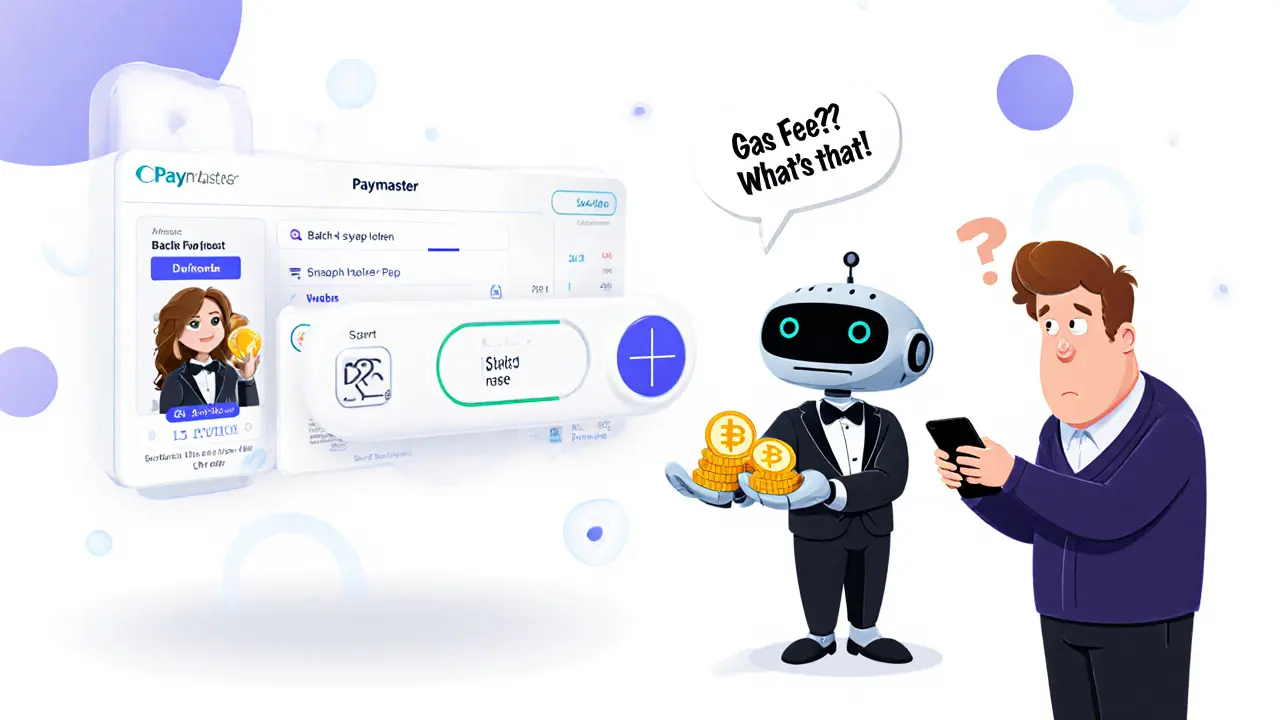ERC-4337 Gas Fee Estimator
Gas Cost Comparison Tool
Calculate transaction costs using ERC-4337 smart wallets versus traditional wallets
Imagine sending crypto without needing a seed phrase. Or paying transaction fees in USDC instead of ETH. What if you could recover your wallet just by asking a friend - no complex recovery phrases, no panic when you lose your phone? That’s not science fiction. It’s what ERC-4337 makes possible today.
What Exactly Is ERC-4337?
ERC-4337 is a standard on Ethereum that lets users interact with the blockchain using smart contract wallets instead of traditional externally owned accounts (EOAs). EOAs are the old-school wallets you’ve probably used - the ones tied to a 12-word seed phrase. If you lose that phrase, you lose everything. No backup. No recovery. No second chance.
ERC-4337 changes that. It lets you use a smart contract as your wallet. That means you can add features like social recovery, batched transactions, and paying fees in tokens other than ETH. All without changing Ethereum’s core code. That’s the genius of it. It works on top of Ethereum, not inside it.
This wasn’t the first try at account abstraction. Earlier attempts like EIP-86 and EIP-2938 needed hard forks - big, risky upgrades to the whole network. ERC-4337 avoids that. Instead, it uses a decentralized network of relays called bundlers and a single on-chain contract called the EntryPoint (address: 0x5FF137D4b0FDCD49DcA30c7CF57E578a026d2789). These bundlers collect user requests, validate them, and send them to the EntryPoint, which executes them like normal transactions.
How ERC-4337 Works: The Four Key Pieces
ERC-4337 isn’t magic. It’s a system made of four parts that work together:
- UserOperation - This is the transaction request you create. It’s not a regular Ethereum transaction. It’s a structured data object that includes your wallet address, the action you want to take, and how you want to sign it (like a passkey or multi-sig).
- Bundlers - These are nodes that pick up UserOperations from a decentralized mempool (called the alt-mempool). They bundle multiple operations together, pay the gas upfront, and submit them to the EntryPoint contract. Think of them as delivery drivers for your crypto actions.
- EntryPoint Contract - This is the central hub. It’s the only smart contract on Ethereum that handles all ERC-4337 operations. It checks if the signature is valid, if the wallet has enough funds (or if a Paymaster will cover it), and then executes the transaction.
- Paymasters - These are services that pay your gas fees for you. Maybe a dApp wants you to try their platform, so they cover your first transaction. Or a brand sponsors gas for new users. You don’t need ETH to start. That’s huge for onboarding.
Together, these pieces create a system where users don’t need to understand gas, private keys, or transaction nonces. It just works - like using a regular app.
Why This Matters: Real Benefits for Real People
Most people don’t use crypto because it’s too confusing. ERC-4337 fixes the biggest pain points:
- No seed phrases - You can log in with your email, phone, or biometrics. Wallets like Argent and Safe already let you recover access via trusted contacts.
- Gasless transactions - You can send ETH, NFTs, or tokens without holding any ETH. Paymasters cover the cost. This is why Shopify adopted ERC-4337 for merchant payments - sellers don’t need to manage ETH for fees.
- Batched actions - Want to swap tokens, approve a dApp, and stake your LP? Do it all in one click. No five separate transactions. No failed approvals.
- Upgradable wallets - Your wallet can get new features over time. Need better security? Update it. Want to add a new signature method? Do it without moving funds.
Early users are already feeling the difference. One Reddit user lost their phone but recovered their wallet in 20 minutes using their designated guardians. Another user on DappRadar wrote: “Finally don’t have to explain gas fees to my parents when sending them crypto.” That’s the kind of impact that scales adoption.

How It Compares to Traditional Wallets
Here’s how ERC-4337 smart wallets stack up against regular EOAs:
| Feature | ERC-4337 Smart Wallet | Traditional EOA |
|---|---|---|
| Recovery | Yes - social recovery, guardians, multi-sig | No - seed phrase only |
| Gas Payment | Can pay in USDC, DAI, or sponsored | Must pay in ETH |
| Transaction Batching | Yes - multiple actions in one | No - one action per tx |
| Upgradeability | Yes - logic can be updated | No - fixed code |
| Gas Cost | ~10-15% higher due to extra steps | Lower - direct and simple |
| Onboarding | Easy - email, phone, passkeys | Hard - seed phrase, gas, nonce |
For simple transfers, EOAs are still faster and cheaper. But for anything beyond that - DeFi, NFTs, gaming, payments - smart wallets win.
Adoption Is Growing Fast
ERC-4337 launched on mainnet in March 2023. Since then, adoption has exploded.
- Over 1.2 million smart contract wallets have been created across Ethereum and L2s like Arbitrum and Polygon.
- Monthly active users jumped from 50,000 in Q1 2023 to 350,000 by Q3.
- Transactions on ERC-4337 wallets grew 700% quarter-over-quarter in 2023.
- 68% of wallet developers are building support for it, according to Consensys.
Major wallets like Argent, Safe (formerly Gnosis Safe), and Frame already support it. Even Shopify integrated it for crypto payments. And it’s not just for users - developers are building tools to make it easier. Alchemy, Stackup, and Particle offer SDKs that cut implementation time from weeks to days.

Challenges and Criticisms
It’s not perfect.
First, gas costs are higher. Because ERC-4337 adds layers - bundling, validation, Paymaster checks - it uses more gas than a simple EOA transfer. That’s the trade-off for usability.
Second, bundlers can be unreliable. If a bundler goes down, your transaction stalls. Some users report delays of 2-3x longer than normal during peak times. The fix? Use multiple bundlers. Most wallets now connect to 3-5 to avoid single points of failure.
Third, Paymaster compatibility isn’t universal. Not all Paymasters support the same tokens or rules. That’s why the community is pushing EIP-5003 - a standard to make Paymasters interoperable.
And then there’s the big question: Is this the final answer? Vitalik Buterin says no. He calls ERC-4337 a “step in the right direction.” The real goal is protocol-level account abstraction - where Ethereum natively supports smart wallets. That’s planned for after the Dencun upgrade. But ERC-4337 isn’t a dead end. It’s a bridge. Future upgrades will make it even smoother.
What’s Next for ERC-4337?
The roadmap is clear:
- Standardization - EIP-5003 will define how Paymasters and Account Factories work, so they play nice together.
- Better bundlers - More decentralized, more reliable, more geographically distributed.
- Native integration - Eventually, Ethereum’s core will handle account abstraction directly. ERC-4337 will become the foundation, not the end.
- Enterprise use - More brands, platforms, and apps will use it to remove friction for non-crypto users.
By 2025, Messari predicts 40% of all Ethereum transactions will go through ERC-4337 wallets. That’s not a guess. It’s based on current growth trends and developer adoption.
Should You Use It?
If you’re a regular user - yes. If you’re new to crypto, or you’ve ever lost access to a wallet, or you hate explaining gas fees - ERC-4337 wallets are the easiest way in.
If you’re a developer - start experimenting. Use Alchemy’s Embedded Accounts SDK or Stackup’s tools. You can have a working smart wallet in a few days.
If you’re skeptical - that’s fair. It’s new. It’s complex. But the problems it solves are real. Seed phrases are a relic. Paying in ETH is a barrier. Recovering a wallet shouldn’t be a crisis.
ERC-4337 isn’t about making crypto harder for experts. It’s about making it possible for everyone else.
Is ERC-4337 the same as a smart contract wallet?
ERC-4337 is the standard that enables smart contract wallets to work on Ethereum without protocol changes. All ERC-4337 wallets are smart contract wallets, but not all smart contract wallets use ERC-4337. Older ones (like early Gnosis Safe versions) used different methods and lacked features like Paymasters and bundlers.
Do I need ETH to use an ERC-4337 wallet?
No, you don’t need ETH to start. Paymasters can cover your gas fees. For example, if you sign up for a new dApp, they might sponsor your first transaction. But if you want to send tokens without a Paymaster, you’ll need ETH to pay for the transaction yourself.
Can I recover my wallet if I lose my phone?
Yes - that’s one of the biggest advantages. Many ERC-4337 wallets let you set up guardians or trusted contacts. If you lose access, you can ask them to help you recover your wallet. Some even use time delays for security, so no one can rush the recovery.
Is ERC-4337 safe?
It’s as safe as the wallet you choose. ERC-4337 itself is a standard, not a wallet. Wallets like Safe and Argent have been audited and are widely trusted. But if you use a poorly coded wallet, you risk losing funds. Always use well-known wallets with public code and active communities.
Will ERC-4337 be replaced by Ethereum’s native account abstraction?
Eventually, yes - but not soon. Ethereum’s protocol-level account abstraction is planned for after the Dencun upgrade. ERC-4337 is designed to be backward compatible with that future system. So your wallet today will still work tomorrow. You won’t need to move funds or start over.
What wallets support ERC-4337 today?
Popular wallets like Argent, Safe (Gnosis Safe), Frame, and Rabby already support ERC-4337. You can also use wallets built on top of SDKs from Alchemy, Stackup, or Particle. Most new wallets launching in 2024-2025 will include it by default.
Hannah Kleyn
November 15, 2025 AT 11:38gary buena
November 16, 2025 AT 09:27